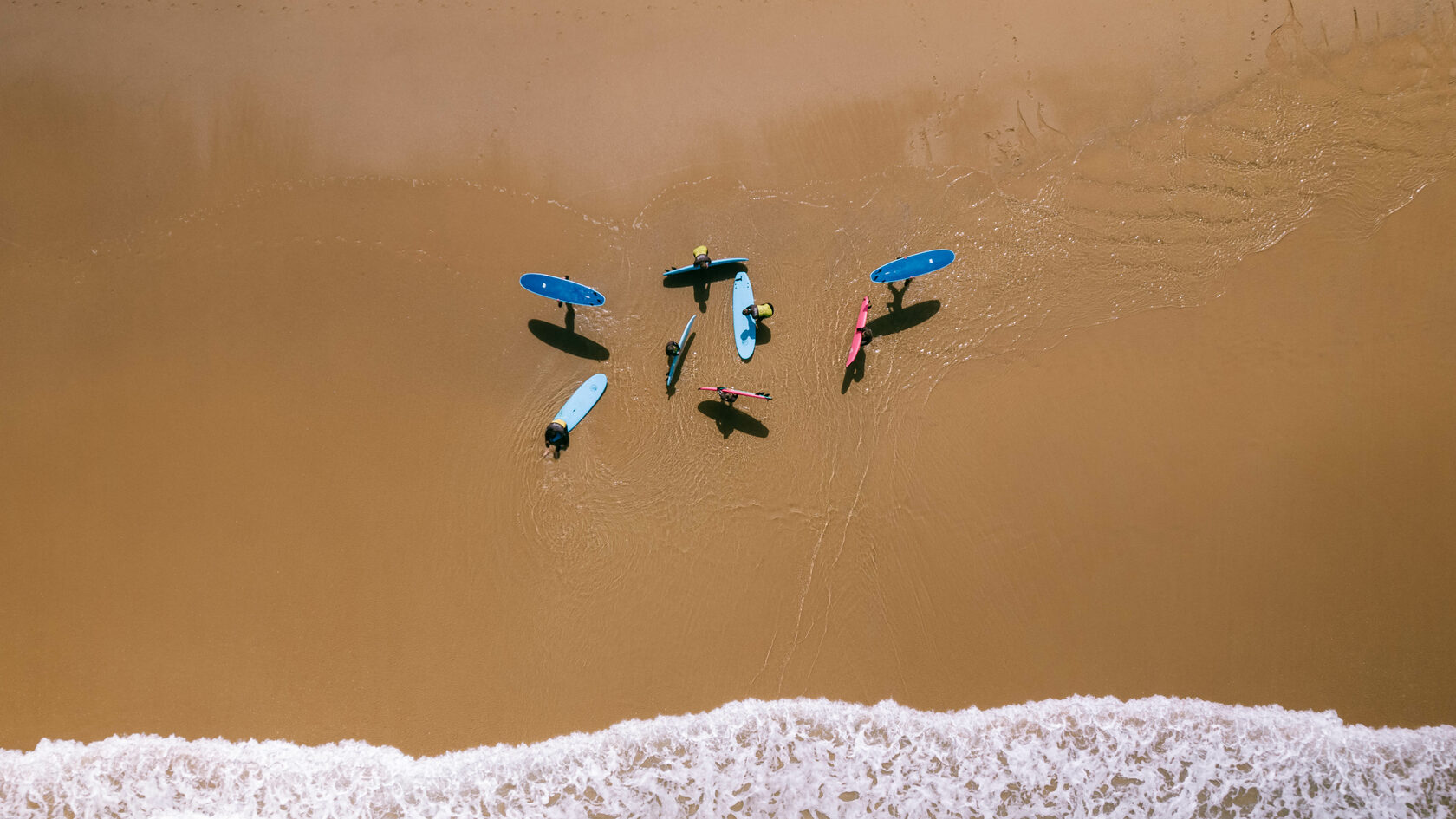Why yoga is important for surfers
Yoga and surfing have a strong connection, and many surfers incorporate yoga into their training routines. Yoga provides numerous benefits that directly complement and enhance the physical and mental aspects of surfing. Let's explore why yoga is important for surfers and delve into some specific yoga exercises that can be beneficial.
Flexibility and mobility
Flexibility and mobility are crucial for surfers to perform fluid movements on the board and navigate through various positions while riding waves. Yoga plays a significant role in improving and maintaining flexibility, which is essential for preventing injuries and enhancing overall surfing performance.
Surfing involves a wide range of motions, including paddling, popping up, turning, and maneuvering on the board. These movements require flexibility in key areas such as the hips, shoulders, spine, and hamstrings. Yoga poses focus on stretching and lengthening these muscles and joints, increasing their range of motion.
One specific yoga exercise that benefits surfers' flexibility is the Downward Facing Dog pose. This pose targets the hamstrings, calves, shoulders, and spine. It helps stretch and elongate the posterior chain, which is essential for paddling and maintaining balance on the surfboard. The Downward Facing Dog also opens up the shoulders, allowing surfers to reach for their board and maintain a strong paddling position.
Surfing involves a wide range of motions, including paddling, popping up, turning, and maneuvering on the board. These movements require flexibility in key areas such as the hips, shoulders, spine, and hamstrings. Yoga poses focus on stretching and lengthening these muscles and joints, increasing their range of motion.
One specific yoga exercise that benefits surfers' flexibility is the Downward Facing Dog pose. This pose targets the hamstrings, calves, shoulders, and spine. It helps stretch and elongate the posterior chain, which is essential for paddling and maintaining balance on the surfboard. The Downward Facing Dog also opens up the shoulders, allowing surfers to reach for their board and maintain a strong paddling position.

Warrior series poses, including Warrior I, II, and III, are excellent for building strength, balance, and flexibility in the hips and legs. These poses engage the core, quadriceps, and glutes while stretching the hip flexors and inner thighs. Increased flexibility in these areas allows surfers to generate power during turns and maneuvers and maintain stability while riding challenging waves.
Triangle pose is another beneficial yoga exercise for surfers' flexibility. This pose stretches the hamstrings, hips, and side body, enhancing mobility and range of motion. It helps surfers achieve a more extended stance on the board and perform powerful turns by increasing lateral flexibility.
Maintaining flexibility in the shoulders is vital for paddling efficiency and wave-catching ability. Yoga poses such as Thread the Needle and Cow Face pose target the shoulder joints, rotator cuffs, and upper back. These poses help release tension in the shoulders and improve the flexibility necessary for paddling with ease and stability.
Incorporating yoga exercises that focus on flexibility into a surf training routine can contribute to improved performance, injury prevention, and a more enjoyable surfing experience. Regular practice of these poses helps surfers develop a supple and agile body, allowing them to adapt to the ever-changing dynamics of the ocean and ride waves with grace and control.
Triangle pose is another beneficial yoga exercise for surfers' flexibility. This pose stretches the hamstrings, hips, and side body, enhancing mobility and range of motion. It helps surfers achieve a more extended stance on the board and perform powerful turns by increasing lateral flexibility.
Maintaining flexibility in the shoulders is vital for paddling efficiency and wave-catching ability. Yoga poses such as Thread the Needle and Cow Face pose target the shoulder joints, rotator cuffs, and upper back. These poses help release tension in the shoulders and improve the flexibility necessary for paddling with ease and stability.
Incorporating yoga exercises that focus on flexibility into a surf training routine can contribute to improved performance, injury prevention, and a more enjoyable surfing experience. Regular practice of these poses helps surfers develop a supple and agile body, allowing them to adapt to the ever-changing dynamics of the ocean and ride waves with grace and control.

Strength and stability
Strength and stability are essential for surfers to maintain control on the board, execute maneuvers, and handle the power of the waves. Yoga provides a unique approach to building strength and stability that complements the physical demands of surfing.
Yoga poses require engagement and activation of various muscle groups, including the core, arms, legs, and back. By holding and transitioning through different poses, surfers can develop functional strength that translates directly to their surfing performance.
One particular yoga exercise that targets both strength and stability is the Plank pose. This pose engages the core muscles, including the abdominals, obliques, and lower back, as well as the arms, shoulders, and legs. Holding the Plank pose builds core strength, which is vital for stability and balance while riding waves. A strong core helps surfers maintain proper posture and control, especially during critical maneuvers and challenging wave conditions.
Boat pose is another beneficial yoga exercise that focuses on core strength. It involves balancing on the sitting bones while lifting the legs and engaging the abdominal muscles. Boat pose strengthens the deep core muscles, including the transverse abdominis, which plays a crucial role in stability and control on the surfboard.
Yoga poses require engagement and activation of various muscle groups, including the core, arms, legs, and back. By holding and transitioning through different poses, surfers can develop functional strength that translates directly to their surfing performance.
One particular yoga exercise that targets both strength and stability is the Plank pose. This pose engages the core muscles, including the abdominals, obliques, and lower back, as well as the arms, shoulders, and legs. Holding the Plank pose builds core strength, which is vital for stability and balance while riding waves. A strong core helps surfers maintain proper posture and control, especially during critical maneuvers and challenging wave conditions.
Boat pose is another beneficial yoga exercise that focuses on core strength. It involves balancing on the sitting bones while lifting the legs and engaging the abdominal muscles. Boat pose strengthens the deep core muscles, including the transverse abdominis, which plays a crucial role in stability and control on the surfboard.

Warrior series poses, such as Warrior I, II, and III, not only improve flexibility but also build strength in the legs, hips, and core. These poses require stability and endurance as surfers hold the poses and transition between them. Warrior poses help surfers develop leg strength, which is necessary for generating power in turns and maneuvers, as well as maintaining balance on the board.
Balancing poses like Tree pose challenge surfers' stability and proprioception. Tree pose involves standing on one leg while finding balance and grounding through the foot and leg. This pose strengthens the ankle, calf, and thigh muscles, which are essential for stability and control while riding waves. Improved stability helps surfers maintain a strong and centered position on the board, even in challenging wave conditions.
It's important to note that yoga not only strengthens the major muscle groups but also activates the smaller stabilizer muscles that support joint stability. This holistic approach to strength training helps prevent imbalances and reduces the risk of injuries that can occur during the dynamic movements of surfing.
By incorporating these strength-focused yoga exercises into their training routine, surfers can develop a well-rounded and functional strength that enhances their overall surfing performance. Improved strength and stability contribute to better wave control, increased endurance, and a reduced risk of injury, allowing surfers to fully enjoy their time in the water and excel in their surfing abilities.
Balancing poses like Tree pose challenge surfers' stability and proprioception. Tree pose involves standing on one leg while finding balance and grounding through the foot and leg. This pose strengthens the ankle, calf, and thigh muscles, which are essential for stability and control while riding waves. Improved stability helps surfers maintain a strong and centered position on the board, even in challenging wave conditions.
It's important to note that yoga not only strengthens the major muscle groups but also activates the smaller stabilizer muscles that support joint stability. This holistic approach to strength training helps prevent imbalances and reduces the risk of injuries that can occur during the dynamic movements of surfing.
By incorporating these strength-focused yoga exercises into their training routine, surfers can develop a well-rounded and functional strength that enhances their overall surfing performance. Improved strength and stability contribute to better wave control, increased endurance, and a reduced risk of injury, allowing surfers to fully enjoy their time in the water and excel in their surfing abilities.

Breath control and endurance
Breath control and endurance are vital aspects of surfing, and yoga provides valuable techniques to improve both. Yoga focuses on conscious breathing practices, known as pranayama, which can greatly benefit surfers in managing breath, increasing endurance, and staying calm in challenging surf conditions.
One specific pranayama technique that surfers can incorporate into their practice is Ujjayi breathing. Also known as "ocean breath," Ujjayi breathing involves inhaling and exhaling through the nose while constricting the back of the throat to create a soft, audible sound. This technique helps regulate and deepen the breath, allowing surfers to take in more oxygen and expel stale air. Ujjayi breathing is particularly useful during intense moments in the water, as it helps surfers maintain a calm and focused state of mind.
Kapalabhati, or "skull-shining breath," is another pranayama technique that can benefit surfers' endurance. It involves forceful exhalations through the nose while keeping the inhalations passive. Kapalabhati helps increase lung capacity, strengthen the respiratory muscles, and improve oxygen utilization in the body. Regular practice of Kapalabhati can enhance surfers' ability to sustain physical exertion and ride waves for longer periods.
One specific pranayama technique that surfers can incorporate into their practice is Ujjayi breathing. Also known as "ocean breath," Ujjayi breathing involves inhaling and exhaling through the nose while constricting the back of the throat to create a soft, audible sound. This technique helps regulate and deepen the breath, allowing surfers to take in more oxygen and expel stale air. Ujjayi breathing is particularly useful during intense moments in the water, as it helps surfers maintain a calm and focused state of mind.
Kapalabhati, or "skull-shining breath," is another pranayama technique that can benefit surfers' endurance. It involves forceful exhalations through the nose while keeping the inhalations passive. Kapalabhati helps increase lung capacity, strengthen the respiratory muscles, and improve oxygen utilization in the body. Regular practice of Kapalabhati can enhance surfers' ability to sustain physical exertion and ride waves for longer periods.

Yoga also teaches surfers the importance of conscious breathing during their practice. By focusing on deep inhales and complete exhales, surfers learn to synchronize their breath with their movements, promoting a greater sense of body awareness and mindfulness. This heightened body-mind connection translates into the water, enabling surfers to stay present, make split-second decisions, and react effectively to changing surf conditions.
In addition to breath control, yoga offers exercises to increase overall endurance, which is crucial for long sessions in the water. Flowing sequences, such as Sun Salutations, create a continuous movement that builds cardiovascular endurance while integrating breath awareness. The repetition of poses and smooth transitions challenge the body's stamina, preparing surfers for longer surf sessions and paddling against currents.
Practicing yoga regularly helps surfers develop a more efficient breathing pattern, improve lung capacity, and enhance their overall endurance. By incorporating breath control techniques like Ujjayi breathing and Kapalabhati, as well as engaging in flowing sequences, surfers can optimize their breath for better performance in the water.
Furthermore, yoga's emphasis on relaxation and stress reduction contributes to improved breath control. Yoga encourages surfers to find moments of stillness and deep relaxation, which can be especially beneficial for managing fear, anxiety, and fatigue in the water. By cultivating a calm and focused mindset through yoga, surfers can optimize their breathing, conserve energy, and enhance their overall surfing experience.
In addition to breath control, yoga offers exercises to increase overall endurance, which is crucial for long sessions in the water. Flowing sequences, such as Sun Salutations, create a continuous movement that builds cardiovascular endurance while integrating breath awareness. The repetition of poses and smooth transitions challenge the body's stamina, preparing surfers for longer surf sessions and paddling against currents.
Practicing yoga regularly helps surfers develop a more efficient breathing pattern, improve lung capacity, and enhance their overall endurance. By incorporating breath control techniques like Ujjayi breathing and Kapalabhati, as well as engaging in flowing sequences, surfers can optimize their breath for better performance in the water.
Furthermore, yoga's emphasis on relaxation and stress reduction contributes to improved breath control. Yoga encourages surfers to find moments of stillness and deep relaxation, which can be especially beneficial for managing fear, anxiety, and fatigue in the water. By cultivating a calm and focused mindset through yoga, surfers can optimize their breathing, conserve energy, and enhance their overall surfing experience.

Mental focus and relaxation
Mental focus and relaxation are crucial aspects of surfing, and yoga provides valuable tools and techniques to enhance these aspects of the surfing experience. By incorporating yoga into their practice, surfers can develop a calm and focused mindset, manage stress and anxiety, and maximize their enjoyment in the water.
Yoga promotes mindfulness, which is the practice of being fully present and engaged in the current moment. Mindfulness allows surfers to stay focused on the task at hand, whether it's reading the waves, positioning themselves on the board, or executing maneuvers. By cultivating mindfulness through yoga, surfers can better tune into the subtle changes in the ocean and make split-second decisions with clarity and confidence.
Meditation is a key component of yoga that supports mental focus and relaxation. Regular meditation practice helps surfers develop mental resilience, improve concentration, and reduce distractions. Meditation involves quieting the mind, observing thoughts without attachment, and cultivating a sense of inner stillness. By incorporating meditation into their routine, surfers can improve their ability to stay present and focused in the water, even in challenging and high-pressure situations.
Yoga promotes mindfulness, which is the practice of being fully present and engaged in the current moment. Mindfulness allows surfers to stay focused on the task at hand, whether it's reading the waves, positioning themselves on the board, or executing maneuvers. By cultivating mindfulness through yoga, surfers can better tune into the subtle changes in the ocean and make split-second decisions with clarity and confidence.
Meditation is a key component of yoga that supports mental focus and relaxation. Regular meditation practice helps surfers develop mental resilience, improve concentration, and reduce distractions. Meditation involves quieting the mind, observing thoughts without attachment, and cultivating a sense of inner stillness. By incorporating meditation into their routine, surfers can improve their ability to stay present and focused in the water, even in challenging and high-pressure situations.

Yoga also offers relaxation techniques that help surfers manage stress and anxiety. Shavasana, also known as Corpse pose, is a deeply restorative posture that promotes relaxation and rejuvenation. It allows surfers to release tension from the body and mind, helping them recover from physical exertion and find a sense of calm. Guided visualization exercises, where surfers imagine themselves riding waves with ease and grace, can also be beneficial in reducing anxiety and instilling confidence.
Yoga's emphasis on deep breathing and conscious breath control contributes to relaxation and mental clarity. By engaging in slow, deep breaths, surfers activate the parasympathetic nervous system, triggering a relaxation response in the body. This relaxation response helps reduce stress, lower heart rate, and induce a sense of calmness. Breath awareness in yoga also helps surfers become more attuned to their body's sensations, allowing them to better gauge their energy levels and make informed decisions in the water.
By incorporating yoga into their routine, surfers can cultivate a balanced mental state, enhancing their overall surfing experience. The practice of mindfulness, meditation, relaxation techniques, and breath control empowers surfers to navigate the challenges of the ocean with greater composure and presence. Whether it's managing fear, maintaining focus, or finding joy in the surfing journey, yoga provides surfers with invaluable tools for nurturing their mental well-being on and off the waves.
Yoga's emphasis on deep breathing and conscious breath control contributes to relaxation and mental clarity. By engaging in slow, deep breaths, surfers activate the parasympathetic nervous system, triggering a relaxation response in the body. This relaxation response helps reduce stress, lower heart rate, and induce a sense of calmness. Breath awareness in yoga also helps surfers become more attuned to their body's sensations, allowing them to better gauge their energy levels and make informed decisions in the water.
By incorporating yoga into their routine, surfers can cultivate a balanced mental state, enhancing their overall surfing experience. The practice of mindfulness, meditation, relaxation techniques, and breath control empowers surfers to navigate the challenges of the ocean with greater composure and presence. Whether it's managing fear, maintaining focus, or finding joy in the surfing journey, yoga provides surfers with invaluable tools for nurturing their mental well-being on and off the waves.

Balance and body awareness
Balance and body awareness are fundamental for surfers to maintain stability on the board and execute precise movements while riding waves. Yoga offers a range of poses and exercises that improve balance, proprioception, and overall body awareness, enhancing surfers' ability to stay centered and agile in the water.
One key aspect of balance in yoga is the activation of the core muscles. Poses like Boat pose and Plank pose engage the deep core muscles, including the abdominals and obliques, which are crucial for stability and balance. Strengthening the core through yoga helps surfers maintain an upright and centered position on the board, especially when faced with turbulent waters or powerful wave breaks.
Tree pose is a classic yoga pose that challenges balance and promotes body awareness. It involves standing on one leg while keeping the other foot pressed against the inner thigh or calf. Tree pose requires surfers to find stability and grounding through the standing leg, while simultaneously elongating the spine and reaching upward. Practicing Tree pose improves balance, strengthens the muscles in the feet and ankles, and enhances the connection between the body and mind.
One key aspect of balance in yoga is the activation of the core muscles. Poses like Boat pose and Plank pose engage the deep core muscles, including the abdominals and obliques, which are crucial for stability and balance. Strengthening the core through yoga helps surfers maintain an upright and centered position on the board, especially when faced with turbulent waters or powerful wave breaks.
Tree pose is a classic yoga pose that challenges balance and promotes body awareness. It involves standing on one leg while keeping the other foot pressed against the inner thigh or calf. Tree pose requires surfers to find stability and grounding through the standing leg, while simultaneously elongating the spine and reaching upward. Practicing Tree pose improves balance, strengthens the muscles in the feet and ankles, and enhances the connection between the body and mind.

Warrior III pose is another beneficial yoga exercise for balance and body awareness. In this pose, surfers extend one leg behind them while hinging forward from the hips, creating a T-shape with their body. Warrior III pose challenges surfers to find stability and engage the core while simultaneously lengthening the back and extending the lifted leg. This pose improves proprioception and helps surfers refine their ability to distribute weight evenly and adjust their body position on the board.
Yoga also incorporates standing balance poses such as Eagle pose and Dancer's pose, which require surfers to find stability while simultaneously elongating and extending the body. These poses improve balance, flexibility, and body awareness, enabling surfers to maintain control and stability while performing maneuvers on the board.
In addition to standing poses, yoga offers seated and supine poses that target balance and body awareness. Poses like Boat pose, Bridge pose, and Camel pose challenge surfers to engage various muscle groups and find stability in different body positions. These poses not only improve balance but also enhance body awareness, helping surfers develop a deeper understanding of their body's alignment and positioning.
By incorporating balance-focused yoga exercises into their routine, surfers can enhance their proprioception, refine their ability to maintain stability on the board, and develop a heightened sense of body awareness. Improved balance and body awareness contribute to better wave control, precise movements, and the ability to adapt to the ever-changing dynamics of the ocean.
Yoga also incorporates standing balance poses such as Eagle pose and Dancer's pose, which require surfers to find stability while simultaneously elongating and extending the body. These poses improve balance, flexibility, and body awareness, enabling surfers to maintain control and stability while performing maneuvers on the board.
In addition to standing poses, yoga offers seated and supine poses that target balance and body awareness. Poses like Boat pose, Bridge pose, and Camel pose challenge surfers to engage various muscle groups and find stability in different body positions. These poses not only improve balance but also enhance body awareness, helping surfers develop a deeper understanding of their body's alignment and positioning.
By incorporating balance-focused yoga exercises into their routine, surfers can enhance their proprioception, refine their ability to maintain stability on the board, and develop a heightened sense of body awareness. Improved balance and body awareness contribute to better wave control, precise movements, and the ability to adapt to the ever-changing dynamics of the ocean.

Specific Yoga Exercises for Surfers:
Sun Salutations:
A flowing sequence of poses that warms up the body, builds strength, and increases flexibility.
Dolphin Pose:
Strengthens the shoulders, arms, and core while stretching the hamstrings.
Pigeon Pose:
Opens the hips, stretches the glutes, and releases tension in the lower back.
Tree Pose:
Enhances balance and stability while strengthening the legs and core.
Child's Pose:
A restorative pose that promotes relaxation and releases tension in the back and shoulders.
A flowing sequence of poses that warms up the body, builds strength, and increases flexibility.
Dolphin Pose:
Strengthens the shoulders, arms, and core while stretching the hamstrings.
Pigeon Pose:
Opens the hips, stretches the glutes, and releases tension in the lower back.
Tree Pose:
Enhances balance and stability while strengthening the legs and core.
Child's Pose:
A restorative pose that promotes relaxation and releases tension in the back and shoulders.

Remember, it's important to practice yoga with proper guidance and listen to your body's limits. Incorporating yoga into your surf training routine can improve your overall surfing performance, prevent injuries, and create a harmonious balance between the physical and mental aspects of your surfing journey.
